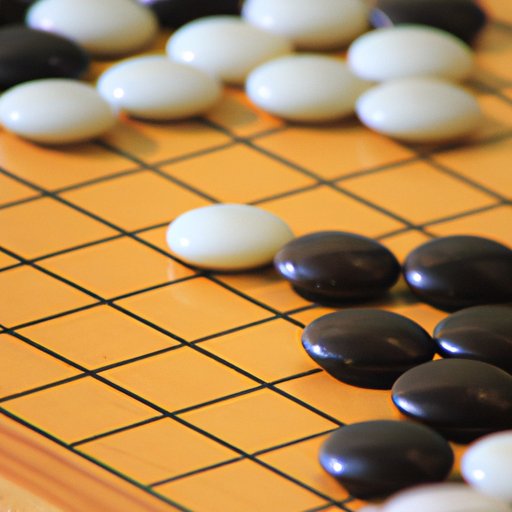I. Introduction
If you’re curious about the ancient Chinese board game called go, you’ve come to the right place. In this article, we’ll be discussing how to play go, its rules, and some basic strategies as well as more advanced techniques that will help you become a better player. Whether you’re a beginner or an experienced player, this guide is designed to help you improve your game and discover the beauty and complexity of go.

II. Go for Beginners: Simple Guide to Rules and Basic Strategies
Go is a two-player strategy board game that requires critical thinking, patience, and flexibility. The objective of the game is to surround and capture your opponent’s stones while at the same time protecting your own. Each player takes turns placing stones on the intersections of a 19×19 board. If one player’s stones completely surround a group of the opponent’s stones, those stones are captured and removed from the board.
A player’s score is counted by adding the number of empty intersections they surround and the number of stones they have captured. The player with the highest score at the end of the game wins.
Some basic strategies in go include making strong shapes, building territories, and avoiding weaknesses. You should try to create strong positions on the board that are difficult for your opponent to invade or attack. Building territories, or groups of connected stones, is also a key element of the game. By creating more and bigger territories, you increase your chances of winning the game. Avoiding weaknesses, such as creating groups that are too weak to defend or too difficult to escape, is also essential in go.
III. 5 Tips to Improve Your Go Game
If you want to improve your go game, here are five tips that you should consider.
Tip 1: Understand the importance of balance
Go is a game of balance where you have to manage your strengths and weaknesses. By understanding the importance of balance, you can effectively respond to your opponent’s attacks while also building your own position. You need to balance your aggression with caution, your offense with defense, and your short-term gains with long-term strategy.
Tip 2: Review your games and learn from your mistakes
One of the best ways to improve your go game is to review your past games and analyze your mistakes. By reviewing your games, you can identify your weaknesses and learn from them. You can also learn from your opponent’s moves and try to anticipate their future strategies.
Tip 3: Play against stronger players
If you want to improve your go game, you should regularly play against stronger players. By playing against stronger opponents, you will be challenged to learn new strategies and techniques. You can also learn from their mistakes and try to exploit their weaknesses.
Tip 4: Practice solving life and death problems
Life and death problems are a crucial part of go strategy. By practicing solving life and death problems, you will improve your reading skills and be able to anticipate your opponent’s moves more effectively. Life and death problems are usually presented as a sequence of moves that lead to the capture or escape of a group of stones.
Tip 5: Learn from professional games
Watching professional games is a great way to learn new strategies and techniques. By studying the moves of professional players, you can improve your own game and discover new ways of thinking about the board. Watching professional games can also be entertaining and inspiring!
IV. Mastering the Art of Go: Techniques Every Player Should Know
If you want to take your go game to the next level, you should learn some more advanced techniques and strategies. Here are some techniques that every go player should know:
Tesujis
Tesujis are clever tactics that involve strategically placing stones to create unexpected and advantageous positions. Tesujis can be used to attack your opponent, defend your own position, or gain control of key points on the board.
Shape
The shape is the fundamental building block of a position in go. By creating good shape, you can make your position stronger and more difficult to attack. Good shape refers to stones that are well placed and connected to each other, forming a cohesive group that is difficult to capture.
V. Understanding Life and Death in Go: Essential to Winning
Life and death is a fundamental concept in go that every player must understand. In essence, life and death refers to the ability of stones to escape or survive capture. Knowing how to create and destroy living groups is essential in winning the game.
There are many life and death problems that you can practice in order to improve your reading skills. By solving these problems, you will become more proficient at identifying life and death situations and making the right decisions.
VI. A Beginner’s Guide to Reading the Go Board
Reading the board is an essential skill in go. By reading the board, you can anticipate your opponent’s moves and develop the best strategies for your own play. Here are some tips for beginners:
Understand the direction of play
The direction of play refers to the flow of the game and the order in which players make their moves. By understanding the direction of play, you can anticipate your opponent’s moves and develop the best strategies for your own play.
Avoid common mistakes
Reading the board can be challenging, especially for beginners. Some common mistakes to avoid include reading too far ahead, misreading the position of stones, and ignoring the importance of shape.
VII. Go Openings: How to Make the First Move Count
The opening phase of go is critical for setting up your position and developing your strategy. Here are some common opening strategies:
The 4-4 point
The 4-4 point is a popular opening move because it offers the most flexibility and allows you to develop your position in many different directions.
The 3-4 point
The 3-4 point is another popular opening move because it can be used to develop your position in a specific direction.
The star point
The star point is a less common opening move, but it can be used to develop a strong position in the center of the board. It is also useful for attacking your opponent’s position.
VIII. Famous Go Games: The Greatest Battles in History and What You Can Learn from Them
Studying famous go games is a great way to learn new strategies and techniques. Here are some famous games that you might want to study:
The Ear-reddening Game
The Ear-reddening Game is a famous game played in 17th century Japan between Honinbo Dosaku and Sakata Eio. It is named after a story that relates how one of the players was so engrossed in the game that his ears turned red. This game is famous for its complex fighting sequences and its dramatic finish.
The Meijin Title Match
The Meijin Title Match is a famous series of games played between Go Seigen and Fujisawa Kuranosuke in the 1930s. This series of games is famous for its innovative strategies and its amazing fighting sequences.
IX. Conclusion
Playing go is a challenging and rewarding experience. By mastering the basics, learning advanced techniques, and studying famous games, you can become a better player and appreciate the beauty and complexity of this ancient Chinese board game.
